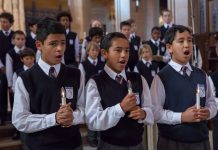
by Fr. James Heft, SM, PhD
Recent media coverage about the Catholic Church does not inspire confidence. We continue to read about sexual abuse by our clergy, the large number of Catholics who have left the Church for another faith or none at all (one in ten, according to a Pew Charitable Trust Survey), and the growing number of “nones,” that is the increasing number of young Americans who no longer identify with any church or religion.
From 1970 to 1990, the number of people who identified themselves as “nones” stays at about 7%. Starting in 1990, however, that number began to rise sharply, reaching 17% in 2010. And for those who are 18 to 29 years of age, that number rose steadily from 12% to 27%.
Couple these developments with another phenomenon—the increasing interest in “spirituality”—and we discover that the world we live in is complex, to say the least. A decline in religion and a growth in spirituality? Sociologists use the word churn to describe the current religious scene in the United States.
Religion: Changing and Surviving
These developments affect not only Christians, who constitute 85% of the United States. They also affect Jews and other religious people in the developed world. Jonathan Sacks, the Chief Rabbi of London, recently asked why we need religion today to explain the universe since we have science, or to control the universe since we have technology. If we are ill, he continues, we go to a doctor, not a priest or a rabbi. If we feel guilty, we go to a psychiatrist, not to confession. Finally, he writes, “if you seek salvation you go to our new cathedrals, namely shopping centers, where you can buy happiness at extremely competitive prices.”1
Despite all this, religion has somehow survived. But it has changed as it has survived. What should we make of all this churning? What contributes to this new situation? What should we think of the so called “spiritual but not religious” movement? Is it mainly a negative trend, a positive one, or both? And what approaches should religious educators and catechists take in the face of these developments?
Historical Background: It Isn’t That New
I think it would help to understand that all this churning did not begin in the last decade or even in the fabled 1960s. Seeds sown by the European Enlightenment (think seventeenth and eighteenth centuries) began to take root and sprout practices in the eighteenth and nineteenth centuries that made religion (in this instance, Christianity) a private matter best kept out of government and economic life. Best understood as only a family matter—a good way to raise children—religion, in the minds of these thinkers, became dangerous (even caused wars) when it reached into the public sphere with its dogmas and condemnations. By contrast, science is based on reason; these thinkers believed it was the sure path to a better future.
By the middle of the nineteenth century in the United States, influential writers like Ralph Waldo Emerson mocked organized religion (especially Calvinism) as rigid and irrelevant, and described preachers as bores.
At the beginning of the twentieth century, William James, a leading thinker in psychology and philosophy, once described religion as “the feelings, acts and experiences of individual men in their solitude.”2 He explained that when people thought of religion, they thought of some church which suggested to them “so much hypocrisy and tyranny and meanness and tenacity of superstition” that they just dismissed it.3 James wasn’t especially happy about all this, but he did think religion was really best understood as what people experienced when they were alone and enjoyed deep thoughts. Today, in our urban environments, it’s harder to be alone, and a dizzying array of media makes deep thoughts rare.
In the 1950s and 1960s, sociologists wrote about “teenagers” and “adolescents” as a stage brought about as a result of mass education, the legal condemnation of child labor, urbanization and suburbanization, and the creation of a consumer and entertainment culture. Now, instead of writing about the three stages of childhood, adolescence, and adulthood, sociologists have discovered that they have to insert a fourth stage: emerging adulthood.
Youth today physically mature sooner than before and assume adult responsibilities later than ever. One sociologist, Jeffrey Arnett, describes emerging adults as unstable, locked into prolonged identity searches, focused on themselves, feeling in limbo and transition, and, paradoxically, retaining a sense of possibility and hope. In a highly mobile society where the Internet, social media, music, and movies can exert more powerful influence than a religious tradition or a single family, is it any wonder that an increasing number of emerging adults lose touch with the religious traditions in which they may have been raised?
Spiritual but Not Religious: Challenges
Christian Smith, an important sociologist of religion, describes the religious outlook of most U.S. teenagers as moral therapeutic deism (MTD). For them, religion has more to do with rules (morals) than relationships, gives great value to feeling good (therapeutic) about themselves, and speaks of God (deism) rather than of Jesus. They rarely spend time reading Scripture and they don’t understand the Sacraments as encounters with Jesus. They are, as Smith describes them, “sub-trinitarian” (deism). Their lives are busy with school, social events, friends, texting, and entertainment; few of them give their religious faith top billing.
When teenagers get to college, they likely hear even more that suggests being spiritual but not religious is to be more open, more adult, freer of confining traditions than their parents, especially if their parents are religious. They might study a variety of religions and be taught that all religions are basically the same—teach the same values—and that what is most important is to be a good person. Many are taught that mature people transcend any one religious tradition and adopt a spirituality that embraces everyone.
One Jewish writer in the Reform tradition recently described spirituality as “a feeling of awe, wonder, and radical amazement in response to the universe,” an attitude that recognizes the “ultimate Unity of All Being” and the “sanctity” of every person. The writer continues: Spirituality is a trust that there is enough for everyone, and that the world is “filled with a conscious energy that transcends the categories and concepts” that religious people use to describe reality. By contrast, he describes religions as “various historical attempts to organize a set of doctrines, rituals, and specific practices which are supposed to be ‘the right way to live.’”4
For people who root their spirituality in their religious tradition, such a sharp contrast between the two makes no sense. Opposing spirituality to religion often ends up in seeking spiritual highs without the discipline offered by a community and a tradition. Lawrence Cunningham, a keen Catholic observer of the spiritual life, warns that much of the spirituality market today is scarred by a highly narcissistic preoccupation not unlike old self-improvement schemes.
Spirituality and the Lived Experience
That said, it would be wise not to dismiss completely the hunger for spirituality as always narcissistic or a hobby of the self-absorbed. In the latter part of the twentieth century, major Catholic theologians who sometimes disagreed with each other nonetheless agreed that greater attention needed to be paid to the lived experience of people.
German theologian Karl Rahner believed that in our own time, if Christianity was to survive, it would have to become “mystical.” By mystical he was not suggesting that everyone had to have extraordinary religious experiences, such as visions or ecstasies. What he wanted to stress was that religious practices, to be authentic, needed to take root in daily living and the awareness of “mystery”—another easily misunderstood word by which he simply used to refer to that deeper part of life that is not easily understood.
Similarly, Swiss theologian Hans Urs von Balthasar, who often sharply criticized Rahner, thought the perception of beauty—not only in art but in the lives of the saints, especially Christ, and indeed the crucified Christ—is what first attracts a person to living the Christian life. The Christian, von Balthasar was fond of saying, is in love with the love that appeared in Christ. Once this beauty and love are experienced, there is a desire to live the lives of beauty that they see in the saints, in the great works of art, in the glory of nature and of God’s goodness. For him, truth should never be separated from love, which is the core of everything.
To mention just one more theological giant, Canadian theologian Bernard Lonergan, toward the end of his life, came to a similar conclusion: At the core of the Christian life is the experience of falling in love—the ultimate goal of life, where faith deepens by recognizing God’s love for everyone.
All three of these highly influential theologians realized this: That the traditional objective proofs for God’s existence, that an intellectual grasp of Catholic teachings, and that just keeping the rules—none of these by themselves—make people spiritually mature. In short, for all of them, love prepares the way for genuine faith.
Taking these three theologians seriously suggests that the “spiritual but not religious” movement might actually be a positive development. Many of our young people have been baptized but have not yet converted, have been catechized but have not yet fallen in love. On the other hand, there are real risks, especially for those young people who no longer participate in the life of the Church. The larger culture—primarily consumeristic, materialistic, and relativistic—will offer them little encouragement to search deeply in their hearts for the meaning of life.
Suggestions for Religious Educators: Opportunities
It is important to remember that the Holy Spirit never abandons the Church, and especially those who, with courage, competence, and generosity, try to pass on the tradition to the next generation. There should be little doubt that over the past 60 years or so, we have undergone a cultural, and therefore religious, revolution.
In the face of these massive shifts, what might be some fruitful approaches for religious educators, especially those who work with young people? I suggest five approaches. There are surely many others, but I have seen these bear real fruit among teenagers and young adults.
1. Intergenerational contact: Informed commentators on religious education stress the importance of family involvement. When parents don’t support the religious education of their children, it is more difficult to make what children learn stay with them. Teachers need to get more adults, especially parents (they have more influence than they realize), involved in this effort.
2. Service as an introduction to love: The three famous theologians I mentioned earlier stressed the centrality of love as key to religious maturity. Young people who are encouraged to serve and help others acquire a “feel” for love. To link that love to the Gospel and to the Church is one of the privileges and tasks of religious educators.
3. Silence for depth: I am not against social media, the Internet, or iPhones. I am against letting them dominate and distract us from a thoughtful existence. There is an appointed time for everything (Ecclesiastes), and one of those things is silence. Youth especially need to learn this discipline, and religious educators should have the courage to lead them into it.
4. Community, a key context: Christianity is like the common cold: It is contagious. You get it from those who have it. The Christian community includes more than one’s contemporaries or one’s fellow citizens. It reaches back in history and includes believers around the world. Telling our stories and listening to the stories of others helps ground us in a larger context and longer history.
5, Doctrines, explanations, and reading: Even though experience and especially love are key doorways into a deeper and more authentic religious life, words and explanations are very important. After all, Christianity is a religion of the Word who not only demonstrated in his life and death what love is but also taught it. We need to be prepared to give an explanation for the hope that is within us (1 Peter 3:15). Increasing one’s intellectual grasp of the faith actually deepens one’s experience of it and equips a person to speak about it.
Love unexpressed in word and deed is not love. Acting on these five suggestions should help believers be both spiritual and religious.
Endnotes
1. “The Meaning-Seeking Animal,” in The Tablet, November 14, 2009, p. 12.
2. The Varieties of Religious Experience (Harmondsworth: Penguin, 1982), p. 31.
3. Ibid., p. 335.
4. Michael Lerner. “Why Spirituality?” Tikkum, Vol. 15, No. 2 (March/April 2000), pp. 7-8.
After 29 years at the University of Dayton, Fr. Heft became the Alton Brooks Professor of Religion and President of the Institute for Advanced Catholic Studies (ifacs.com) at the University of Southern California in 2006. His most recent book, Catholic High Schools: Facing the New Realities, was recently published by the Oxford University Press.
Study Guide
Father Heft begins our series, “Spirituality: Grounding in the Mystery of God,” by identifying the questions, issues, and challenges concerning spirituality in the twenty-first century. He offers a thumbnail sketch of religious trends backed up by current research data that speak to growing perspectives, or churnings, on the relationship of religion and spirituality in contemporary culture. He asks us: “Is this mainly a negative trend, a positive one, or both?” This question offers us an opportunity to delve deeply into our personal experience of affirming or re-defining spirituality in the light of our rich Catholic tradition. As we proceed through our series, we hope to establish a solid ground for exploring this question in a positive and proactive way.
Discussion/Reflection Questions
1. What changes in attitude, practice, or perspective do I see in my family, friends, students, or parish concerning conversations around religion and spirituality? (Be specific.)
2. Based on this article, what do I think are the qualities of a spiritually mature Catholic Christian?
3. Father Heft presents five approaches to support catechetical ministry for cultivating a deeper sense of spirituality. How might I incorporate these approaches into my catechetical plan for the year?
4. What is my understanding of the relationship of spirituality and religion? What significant and recent experiences in my life have deepened my appreciation for the relationship of spirituality and religion?
5. What are the greatest challenges I see for addressing the shifting, or churning, perspectives and practices of young people in my faith community regarding religion and spirituality belonging? (Give examples.)
6. How did the Enlightenment influence shifts in attitude and disposition regarding faith and reason (science)? Where do I continue to see the influence of the Enlightenment impacting religious conversations in the public forum today, e.g., mass media, Internet, or social gatherings?
7. Does my experience of emerging adults relate to the ideas of Christian Smith referenced in Fr. Heft’s article? If so, how and where?
8. Father Heft’s article states: “Opposing spirituality to religion often ends up in seeking spiritual highs without the discipline offered by a community and a tradition.” What does he mean? Do I you agree? (Give specific examples.)
9. Father Karl Rahner, S.J., frequently wrote about daily living and the need for an awareness of “mystery” in our lives. He spoke about an “eclipse of mystery” or “living in a wintery season” to describe the distancing of our times from a deep experience of God. Do I think these are effective metaphors or expressions to define our present times?
10. How can I, as a catechist, open minds and hearts for nurturing a profound sense of “mystery” (as in God) in the modern world?
11. Lonergan believed that “at the core of the Christian life is the experience of falling in love—the ultimate goal of life, where faith deepens by recognizing God’s love for everyone.” What does this mean to me? How can I, as a catechist, communicate this profound insight to my students?
Exercises
1. Engage your students in a mass media research project to study how the meaning of God or language about God is communicated through the mass media. Have students compose a counter-cultural conversation to address any of the negative ideas discovered in their research through a PowerPoint presentation, debate, or other creative media presentation that requires reflective processing of the experience. These ideas may be shared with another class to animate a rich conversation. Conclude with a brief, meaningful prayer experience.
2. Introduce students to a variety of Catholic prayers and ways to pray. Invite students to critically reflect on the language, tone, and expressions used in the text of a prayer. What do they think is the spiritual feeling, attitude, or disposition of the individual composing that prayer? What does the prayer reveal about the author’s experience of God? Does the prayer speak to the students’ relationships with God today? Would the prayer be a meaningful community prayer? Why? Have students create personal prayers that reflect their relationships with God.
3. Visit the Vatican website (vatican.va) and select one or two recent statements of Pope Benedict XVI regarding nurturing a deeper relationship with God in modern times. What invitations does he offer that we can apply in our catechetical classes?
4. Visit the Vatican website (vatican.va) and download Pope Benedict XVI’s encyclical letter Spe salvi (On Christian Hope). Read nos. 13-31. What challenges and invitations does the Holy Father offer for transformation of Christian faith and hope in the modern age? Identify practical approaches that can be translated into your current catechetical practice.
5. Is our American culture (or local community) experiencing an “eclipse of mystery” or is it living in a “wintery season” of an experience of God today? Have students write poetry or create a play or drama to address this question in a positive, proactive way.
6. The Catholic faith is rich in tradition and heritage. Symbols, rituals, and the liturgical life are essential elements to foster a sense of communion with God, community, and one another. Have students engage in a research project to explore the history, meaning, and impact of various symbols, rituals, liturgies, and spiritual exercises for fostering a sense of community within the parish, Catholic school, or faith community. Discuss why these are essential for nurturing a sense of community in the parish (Church).
7. Have students interview friends regarding their ideas about God, their relationship, with God, and how the place of religion (community) supports their relationships with God. A variety of media can be used to capture the interviews. Use these for class discussion or the creation of a class media presentation.
The HTML CheatSheet has its built-in editor where you can preview the document you are working on.
Copyright 2011, Bayard, Inc. All rights reserved. This article is protected by United States copyright and other intellectual property laws and may not be reproduced, rewritten, distributed, redisseminated, transmitted, displayed, published or broadcast, directly or indirectly, in any medium without the prior written permission of Bayard, Inc.
This article was written by the Catechist Staff and appeared in Catechist magazine, August 2011.
Image Credit: Aris Suwanmalee/Shutter Stock 555003484




